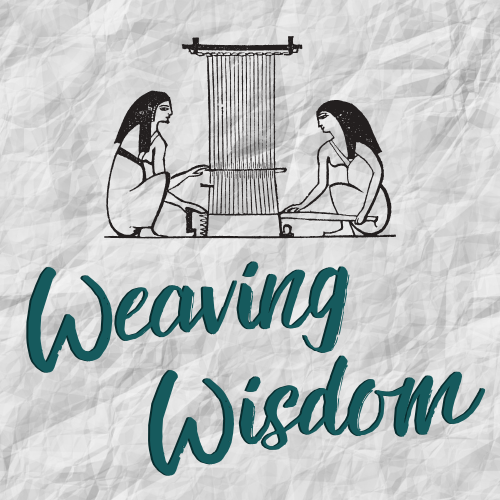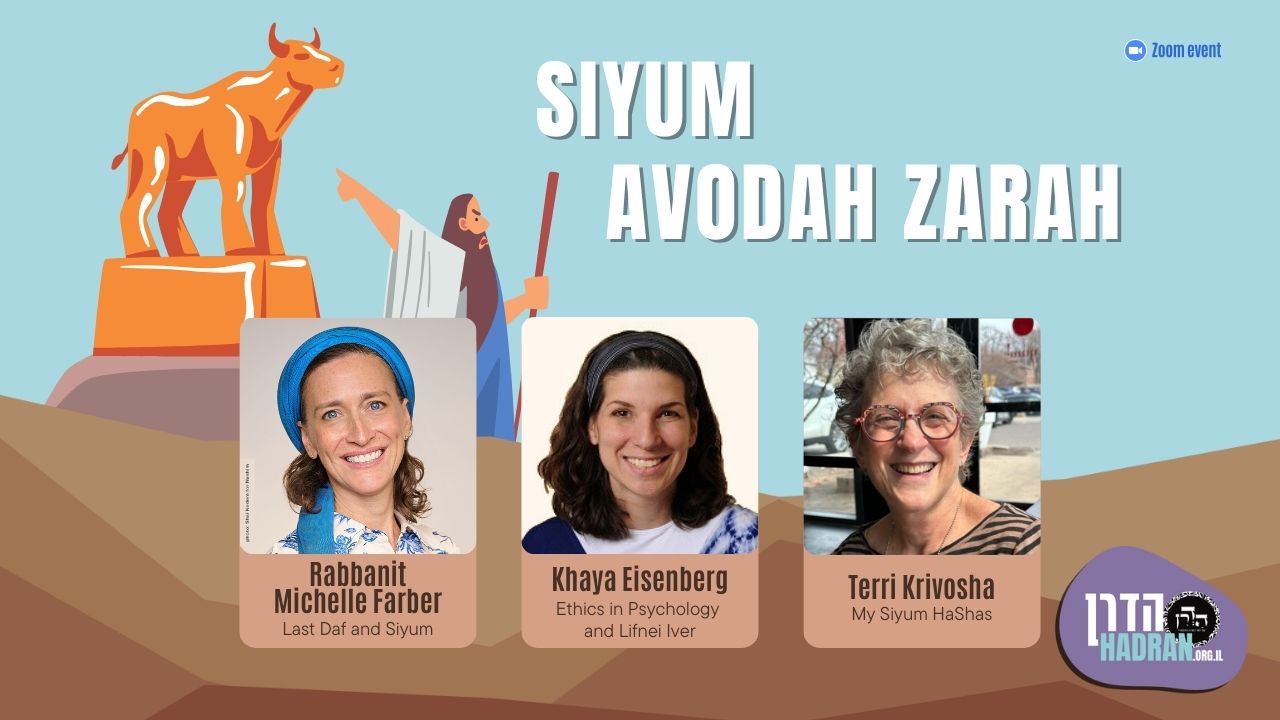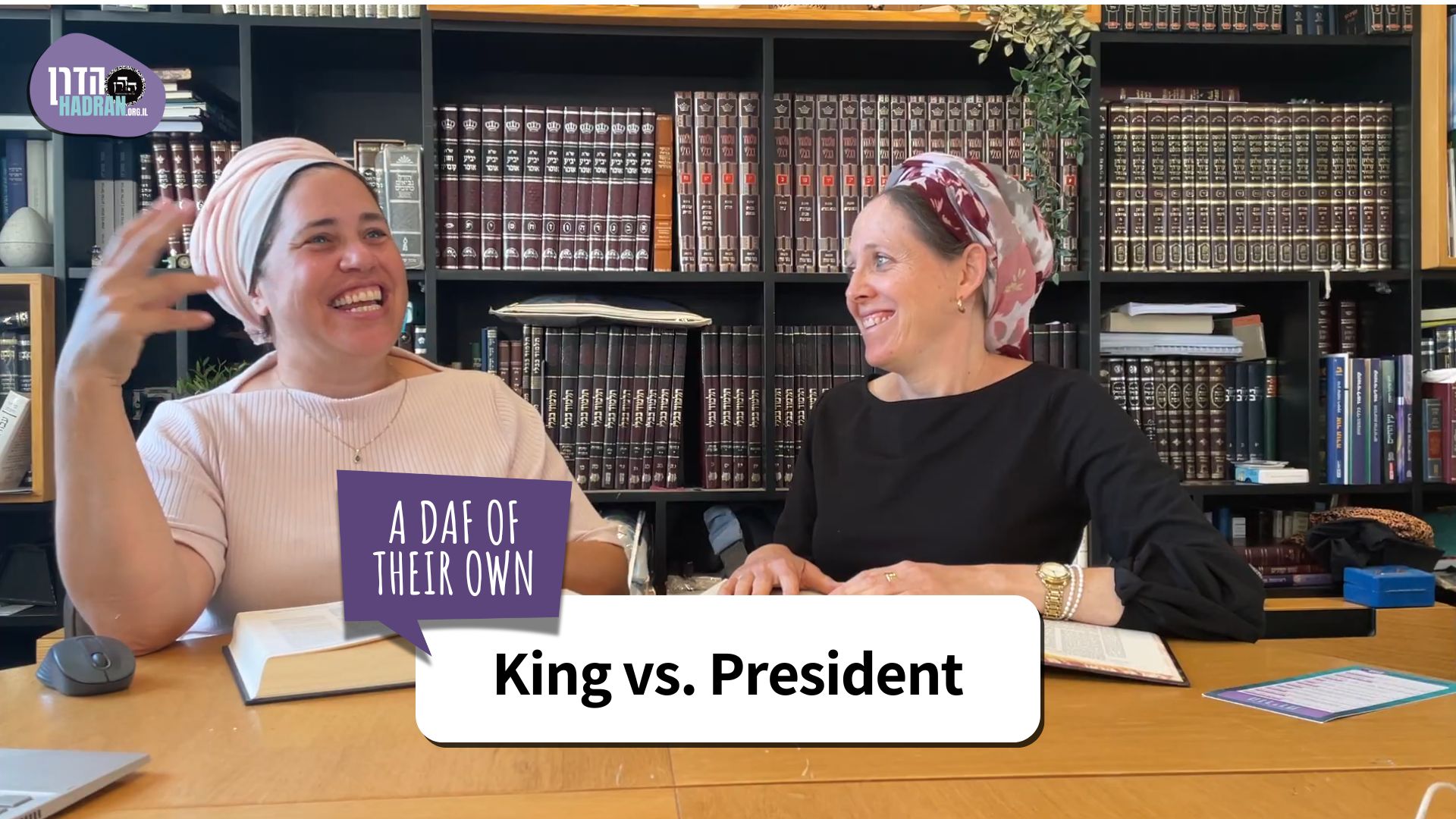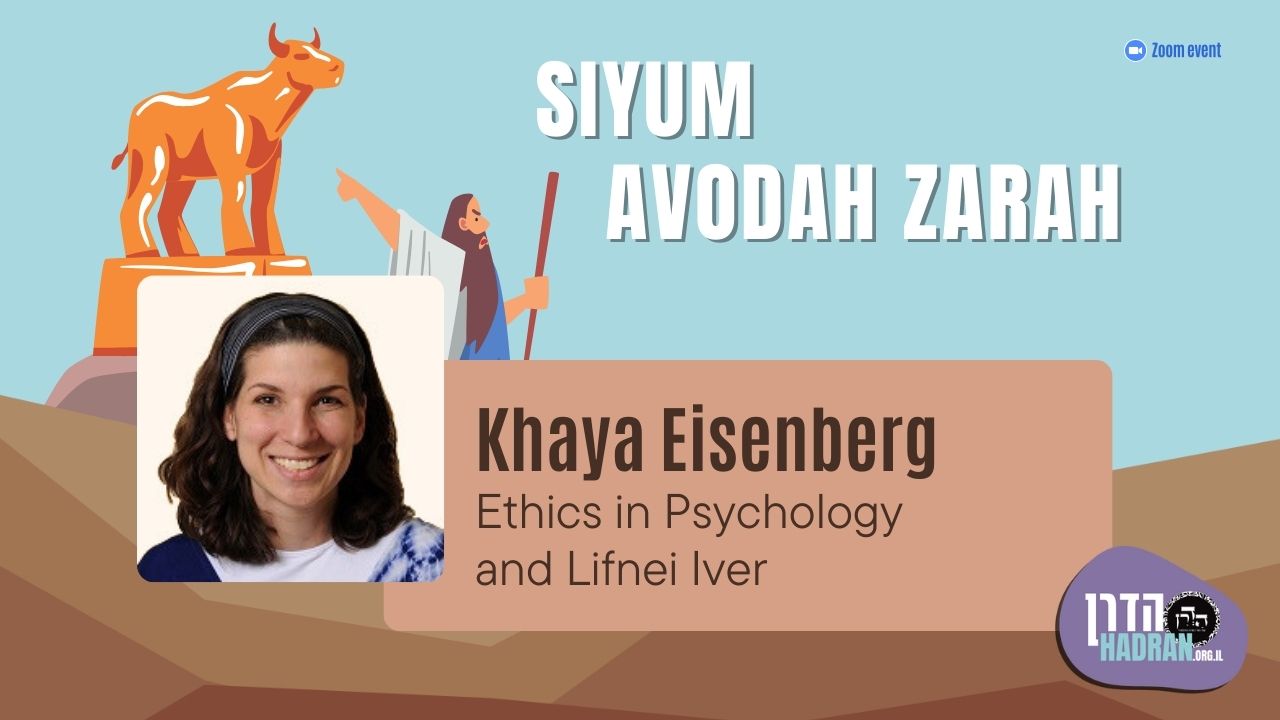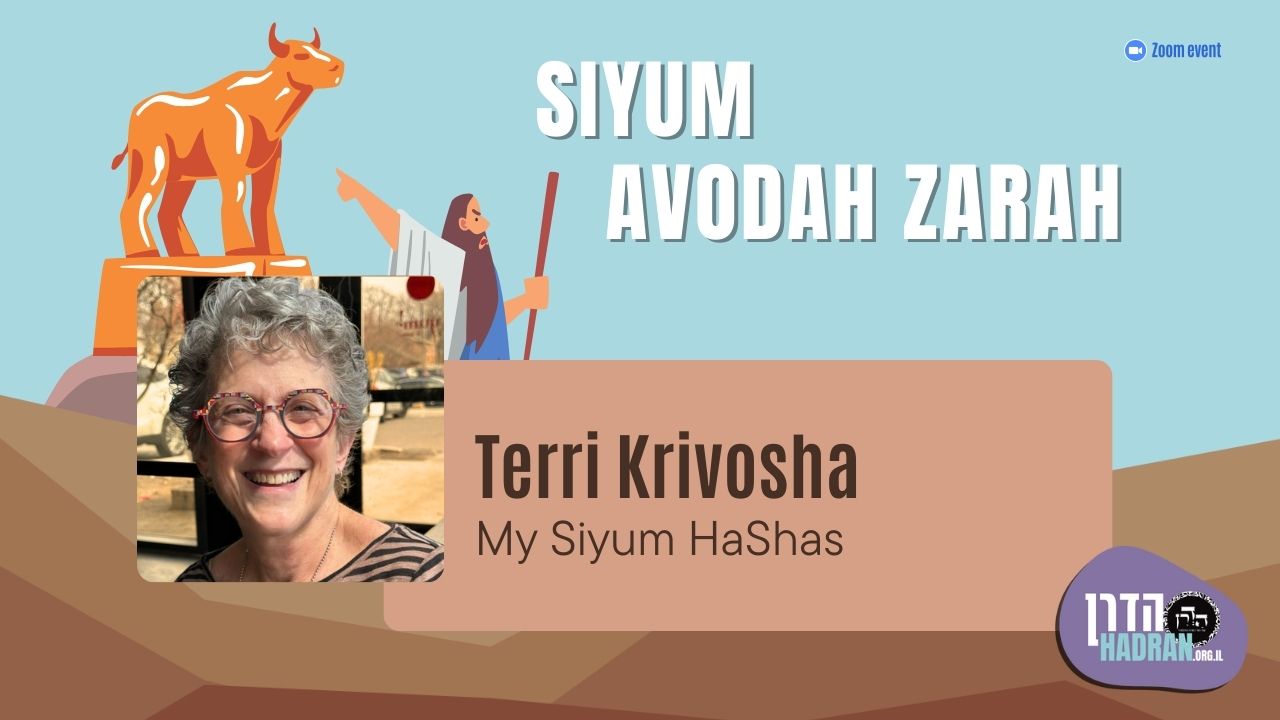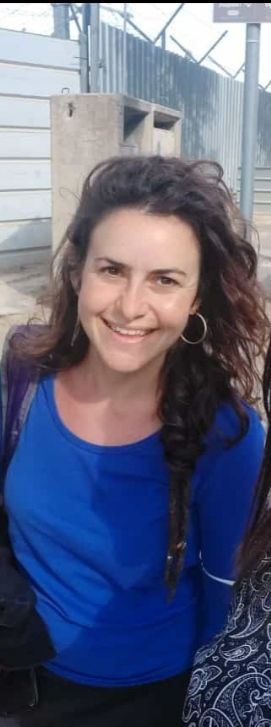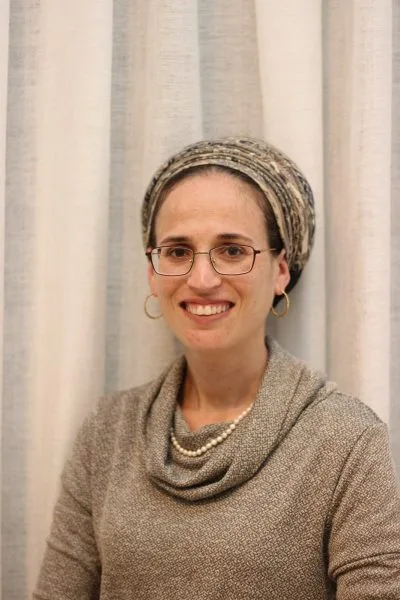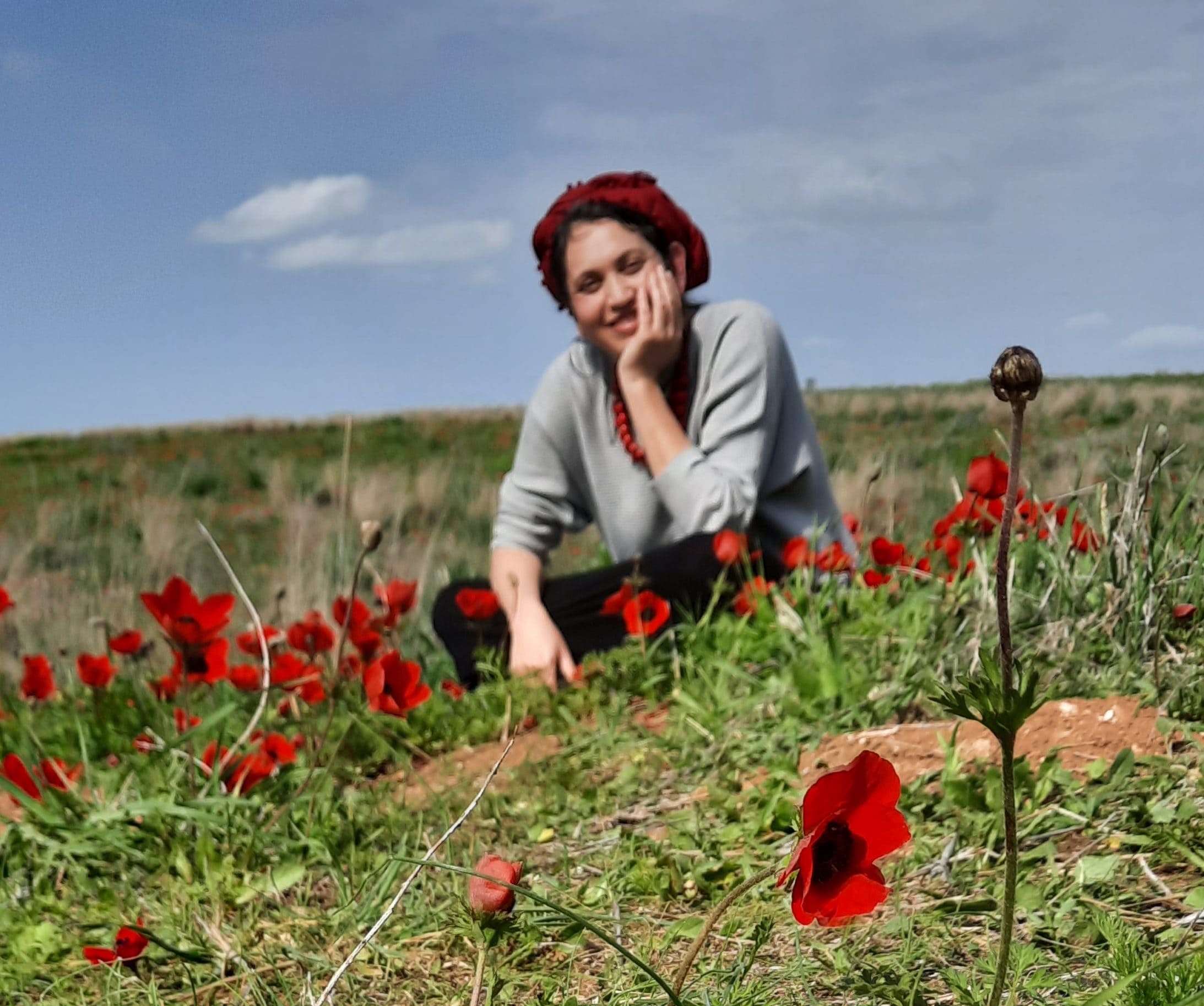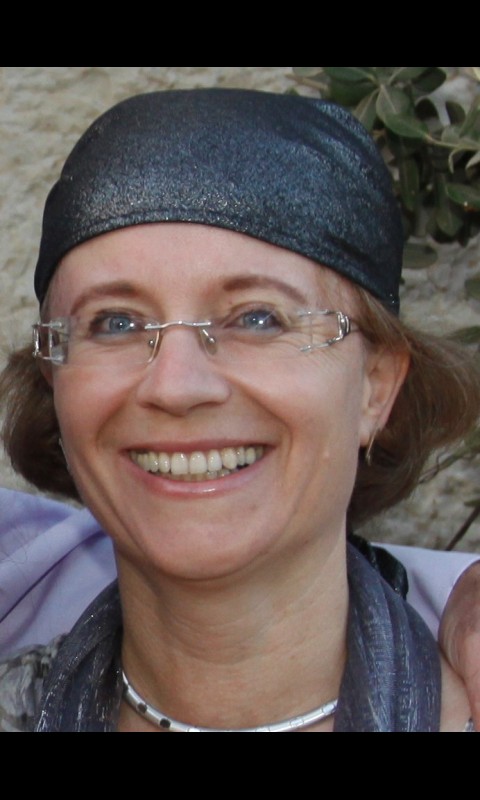רוצים להקדיש למידה? התחל כאן:

תקציר
העמקה
רוצה להבין מה באמת קורה מתחת לפני השטח של הסוגיה?
שיעורים, פודקאסטים והרחבות של מיטב המורות שלנו יפתחו לך עוד זוויות וכיווני חשיבה.
חדשה בלימוד הגמרא?
זה הדף הראשון שלך? איזו התרגשות עצומה! יש לנו בדיוק את התכנים והכלים שיעזרו לך לעשות את הצעדים הראשונים ללמידה בקצב וברמה שלך, כך תוכלי להרגיש בנוח גם בתוך הסוגיות המורכבות ומאתגרות.
פסיפס הלומדות שלנו
גלי את קהילת הלומדות שלנו, מגוון נשים, רקעים וסיפורים. כולן חלק מתנועה ומסע מרגש ועוצמתי.
עירובין עז
וְרַבִּי יוֹחָנָן אָמַר: אֵלּוּ מַעֲלִין מִכָּאן וְאוֹכְלִין, וְאֵלּוּ מַעֲלִין מִכָּאן וְאוֹכְלִין.
And Rabbi Yoḥanan said: These residents of one courtyard may raise food from their courtyard to the top of the wall and eat it there, and they may lower the food from the wall to the courtyard; and those residents of the other courtyard may raise food from their courtyard and eat it there, and they may lower the food from the wall to the courtyard. This is because the wall is considered nonexistent, and its domain is viewed as part of the two courtyards.
תְּנַן: אֵלּוּ עוֹלִין מִכָּאן וְאוֹכְלִין, וְאֵלּוּ עוֹלִין מִכָּאן וְאוֹכְלִין. עוֹלִין — אִין, מַעֲלִין — לָא.
We learned in the mishna: If there was produce on top of the wall, these residents of one courtyard may ascend from this side and eat from it, and those residents of the other courtyard may ascend from that side and eat from it. The Gemara infers from this: To ascend, yes, it is permitted, but to raise food from the courtyard to the top of the wall, no, it is not permitted. This presents a challenge to Rabbi Yoḥanan’s opinion.
הָכִי קָאָמַר: יֵשׁ בּוֹ אַרְבָּעָה עַל אַרְבָּעָה, עוֹלִין — אִין, מַעֲלִין — לָא. אֵין בּוֹ אַרְבָּעָה עַל אַרְבָּעָה — מַעֲלִין נָמֵי.
The Gemara answers that this is what the mishna is saying: If the top of the wall between the two courtyards is four by four handbreadths, then to ascend, yes, it is permitted. However, to raise food, no, it is prohibited, because in that case the top of the wall is considered a domain in its own right. But if it is not four by four handbreadths, it is an exempt domain, and therefore they may raise their food onto the wall as well.
וְאַזְדָּא רַבִּי יוֹחָנָן לְטַעְמֵיהּ, דְּכִי אֲתָא רַב דִּימִי אָמַר רַבִּי יוֹחָנָן: מָקוֹם שֶׁאֵין בּוֹ אַרְבָּעָה עַל אַרְבָּעָה — מוּתָּר לִבְנֵי רְשׁוּת הָרַבִּים וְלִבְנֵי רְשׁוּת הַיָּחִיד לְכַתֵּף עָלָיו, וּבִלְבַד שֶׁלֹּא יַחֲלִיפוּ.
And Rabbi Yoḥanan followed his line of reasoning in this regard, as when Rav Dimi came from Eretz Yisrael to Babylonia, he said that Rabbi Yoḥanan said: With regard to a place that does not have an area of four by four handbreadths and is situated between a public and a private domain, it is permissible for both the people in the public domain and for the people in the private domain to adjust the burden on their shoulders upon it, provided they do not exchange objects between them from one domain to the other domain. This demonstrates that in the case of an exempt domain, Rabbi Yoḥanan was not concerned that one might carry from one domain to another, and permitted members of both domains to use it.
וְרַב לֵית לֵיהּ דְּרַב דִּימִי? אִי בִּרְשׁוּיוֹת דְּאוֹרָיְיתָא — הָכִי נָמֵי.
The Gemara asks: And does Rav, who prohibits carrying in that case even as much as a hair’s breadth, not accept the opinion of Rav Dimi in this matter? The Gemara answers: If this referred to an exempt domain situated between two domains by Torah law, i.e., between a public and a private domain, so too, Rav would agree that the members of both domains may adjust their burdens there.
הָכָא בְּמַאי עָסְקִינַן — בִּרְשׁוּיוֹת דְּרַבָּנַן. וַחֲכָמִים עָשׂוּ חִיזּוּק לְדִבְרֵיהֶם יוֹתֵר מִשֶּׁל תּוֹרָה.
However, with what are we dealing here, in the case of the wall? We are dealing with domains by rabbinic law, and the Sages reinforced their statements even more than those of the Torah. Due to their severity, Torah laws are generally observed. Therefore, there is no need to impose decrees and enactments in order to preserve them. The same is not true of rabbinic decrees; if people ignore the preventive measures, they might come to violate the entire enactment.
אָמַר רַבָּה (אָמַר) רַב הוּנָא אָמַר רַב נַחְמָן: כּוֹתֶל שֶׁבֵּין שְׁתֵּי חֲצֵירוֹת, צִידּוֹ אֶחָד גָּבוֹהַּ עֲשָׂרָה טְפָחִים וְצִידּוֹ אֶחָד שָׁוֶה לָאָרֶץ — נוֹתְנִין אוֹתוֹ לָזֶה שֶׁשָּׁוֶה לָאָרֶץ.
Rabba said that Rav Huna said that Rav Naḥman said: With regard to a wall that is between two courtyards, and one side facing one courtyard is ten handbreadths high, and the other side is level with the ground of the second courtyard, i.e., the second courtyard is built on a higher plane, so that the wall is less than ten handbreadths above its floor, in this case the Sages grant the use of the top of the wall on Shabbat only to the courtyard in which the wall is level with the ground.
מִשּׁוּם דְּהָוֵה לָזֶה תַּשְׁמִישׁוֹ בְּנַחַת וְלָזֶה תַּשְׁמִישׁוֹ בְּקָשֶׁה. וְכׇל לָזֶה בְּנַחַת וְלָזֶה בְּקָשֶׁה — נוֹתְנִין אוֹתוֹ לָזֶה שֶׁתַּשְׁמִישׁוֹ בְּנַחַת.
The reason is because the use of the wall is convenient for one side, i.e., the higher courtyard, but difficult for the other side. The wall can be used more conveniently by the residents of the higher courtyard. And the principle is that in any case with regard to Shabbat where an action is convenient for one party and difficult for another, the Sages grant it to the one for whom its use is convenient.
אָמַר רַב שֵׁיזְבִי אָמַר רַב נַחְמָן: חָרִיץ שֶׁבֵּין שְׁתֵּי חֲצֵירוֹת, צִידּוֹ אֶחָד עָמוֹק עֲשָׂרָה וְצִידּוֹ אֶחָד שָׁוֶה לָאָרֶץ — נוֹתְנִין אוֹתוֹ לָזֶה שֶׁשָּׁוֶה לָאָרֶץ, מִשּׁוּם דְּהָוֵה לֵיהּ לָזֶה תַּשְׁמִישׁוֹ בְּנַחַת וְלָזֶה תַּשְׁמִישׁוֹ בְּקָשֶׁה וְכוּ׳.
Similarly, Rav Sheizvi said that Rav Naḥman said: In the case of a ditch between two courtyards, one side of which is ten handbreadths deep, and the other side of which is level with the ground of the second courtyard, i.e., is less than ten handbreadths below it, the Sages grant the use of the ditch to the courtyard in which the ditch is level with the ground. This is because it is a case in which the use of the ditch is convenient for one side, where it is close to level with the ground, and difficult for the other, where the ditch is ten handbreadths deep, and whenever use of an item is convenient for one party and inconvenient for another, it is granted to the one for whom it is convenient.
וּצְרִיכִי. דְּאִי אַשְׁמְעִינַן כּוֹתֶל, מִשּׁוּם דִּבְגוּבְהָא מִשְׁתַּמְּשִׁי אִינָשֵׁי. אֲבָל חָרִיץ, בְּעוּמְקָא לָא מִשְׁתַּמְּשִׁי אִינָשֵׁי — אֵימָא לָא.
The Gemara comments: And it was necessary to cite both of these cases, as it would not have been possible to learn one from the other, since, had Rav Naḥman taught us only the case with regard to a wall, one could have said that the halakha applies only in that case, because people use an elevated surface. Even for the residents of the lower courtyard, it is relatively easy to use this wall. However, with regard to a ditch, people do not use a deep surface, as it is troublesome to bend down and place an item in a ditch. In that case, one might say that it may not be used by the residents of either courtyard.
וְאִי אַשְׁמְעִינַן בְּחָרִיץ, מִשּׁוּם דְּלָא בְּעִיתָא תַּשְׁמִישְׁתָּא. אֲבָל כּוֹתֶל דִּבְעִיתָא תַּשְׁמִישְׁתָּא — אֵימָא לָא, צְרִיכָא.
And likewise, had he taught us only the case with regard to a ditch, one could have said that the halakha applies only in that case, because its use does not cause worry, as anything placed in the ditch is protected. However, with regard to a wall, the use of which causes worry that the objects placed there are liable to fall, one might say that it may not be used by the residents of either courtyard. Therefore, it was necessary to state both of these rulings.
בָּא לְמַעֲטוֹ, אִם יֵשׁ בְּמִיעוּטוֹ אַרְבָּעָה — מוּתָּר לְהִשְׁתַּמֵּשׁ בְּכׇל הַכּוֹתֶל כּוּלּוֹ. וְאִם לָאו — אֵין מִשְׁתַּמֵּשׁ אֶלָּא כְּנֶגֶד הַמִּיעוּט.
With regard to a wall between two courtyards, the Gemara states: If one comes to diminish the height of the wall by placing a stone next to it, or by building a platform in order to permit its use or to utilize it as a passageway to another courtyard, the following distinction applies: If the diminished section is at least four handbreadths wide, it is permitted to use the entire wall. This area has the status of an entrance and the two courtyards are considered one, which renders the entire wall permitted. However, if the diminished section is not at least four handbreadths wide, one may use only the area of the wall opposite the diminished section, but no more.
מָה נַפְשָׁךְ? אִי אַהֲנִי מִעוּטָא — בְּכוּלֵּיהּ כּוֹתֶל לִישְׁתַּמֵּשׁ. אִי לָא אַהֲנִי — אֲפִילּוּ כְּנֶגֶד הַמִּיעוּט נָמֵי לָא. אָמַר רָבִינָא: כְּגוֹן שֶׁעָקַר חוּלְיָא מֵרֹאשׁוֹ.
The Gemara challenges this ruling: Whichever way you look at it, this ruling is difficult. If the diminishing was effective, although it extends less than four handbreadths, let him use the entire wall; and if the diminishing was not effective, even the area corresponding to the diminished section should also not be permitted for use, as this section is insignificant. Ravina said: Here, it refers to a case where one removed a segment of stone from the top of the wall. Since the wall is actually less than ten handbreadths high along that section, it is fit for use as is an opening in the wall.
אָמַר רַב יְחִיאֵל: כָּפָה סֵפֶל — מְמַעֵט.
Rav Yeḥiel said: If one overturned a basin and placed it next to a wall, such that the wall is no longer ten handbreadths high, it effectively diminishes the height of the wall.
וְאַמַּאי? דָּבָר הַנִּיטָּל בְּשַׁבָּת הוּא, וְדָבָר הַנִּיטָּל בְּשַׁבָּת אֵינוֹ מְמַעֵט. לָא צְרִיכָא, דְּחַבְּרֵיהּ בְּאַרְעָא.
The Gemara asks: And why should this be so? Isn’t this basin an item that may be moved on Shabbat, i.e., something that one is permitted to handle? And the principle is that an item that may be moved on Shabbat does not diminish a wall. Since it can be removed at any moment on Shabbat, such an object cannot be viewed as a permanent part of the wall. The Gemara answers: No, it is necessary; this basin can be considered a permanent part of the wall in a case where he attached the basin to the ground by covering it with soil. The basin may then not be moved on Shabbat due to the prohibition of handling soil.
וְכִי חַבְּרֵיהּ בְּאַרְעָא, מַאי הָוֵי? וְהָא תַּנְיָא: פַּגָּה שֶׁהִטְמִינָהּ בְּתֶבֶן, וַחֲרָרָה שֶׁהִטְמִינָהּ בְּגֶחָלִים, אִם מְגוּלָּה מִקְצָתָהּ — נִטֶּלֶת בְּשַׁבָּת.
The Gemara challenges this explanation: And if one attached the basin to the ground, what of it? Wasn’t it taught in a baraita: With regard to an unripe fig that one buried in straw intended for kindling, so that it would ripen, or a cake that one buried in coals before Shabbat, and the coals were extinguished, if part of either one is visible, it may be moved on Shabbat. This is not prohibited, although as a result one will move the straw or the coals, which are set aside.
הָכָא בְּמַאי עָסְקִינַן, דְּאִית לֵיהּ אוֹגְנַיִים.
The Gemara explains: With what are we dealing here? We are dealing with a case where the top of the basin has a rim that is fully buried in the ground, so that removing the basin will dislodge the earth under which it is buried in a manner similar to digging, which is prohibited on Shabbat.
וְכִי אִית לֵיהּ אוֹגְנַיִים, מַאי הָוֵי? וְהָתְנַן: הַטּוֹמֵן לֶפֶת וּצְנוֹן תַּחַת הַגֶּפֶן, בִּזְמַן
The Gemara further challenges this explanation: And if the basin has a rim, what of it? Didn’t we learn in a mishna: With regard to one who buries a turnip or a radish in the ground beneath a vine for safekeeping, when
שֶׁמִּקְצָת עָלִין מְגוּלִּין אֵינוֹ חוֹשֵׁשׁ לֹא מִשּׁוּם כִּלְאַיִם, וְלֹא מִשּׁוּם מַעֲשֵׂר, וְלֹא מִשּׁוּם שְׁבִיעִית, וְנִיטָּלִין בַּשַּׁבָּת!
some of the leaves of the turnip or radish are showing, he need not be concerned due to diverse kinds, i.e., that he violated the prohibition of planting food crops in a vineyard, as he did not intend to commit an act of planting; nor due to tithes, i.e., there is no concern lest the turnip or radish grew further, in which case he would be obligated to tithe it; nor due to the prohibition against working the land during the Sabbatical Year, and similarly, he need not be concerned that they grew further and that the additional growth is prohibited as produce that grew during the Sabbatical Year. And therefore, the turnip or radish may be taken from the ground on Shabbat. Even if most of the turnip or radish is underground, it is permitted to pull it from the ground on Shabbat. If so, in the case described in the mishna here, even if the basin buried in the ground has a rim, it should nevertheless be permitted to move it.
לָא צְרִיכָא, דְּבָעֵי מָרָא וַחֲצִינָא.
The Gemara answers: No, Rabbi Yeḥiel’s ruling is necessary in a case where the basin was so firmly attached to the ground that one would need a hoe [mara] or a spade to remove it, as this action would certainly involve digging, which is prohibited on Shabbat. Therefore, since the basin cannot be removed on Shabbat, it is considered fixed in its place and effectively diminishes the height of the wall.
סוּלָּם הַמִּצְרִי אֵינוֹ מְמַעֵט וְהַצּוֹרִי מְמַעֵט. הֵיכִי דָּמֵי סוּלָּם הַמִּצְרִי? אָמְרִי דְּבֵי רַבִּי יַנַּאי: כֹּל שֶׁאֵין לוֹ אַרְבָּעָה חֲווֹקִים.
It was taught in a baraita: An Egyptian ladder, which is small, does not diminish the height of a wall, whereas a larger, Tyrian ladder effectively diminishes its height. The Gemara asks: What are the circumstances of an Egyptian ladder; i.e., what characterizes it? The scholars of the school of Rabbi Yannai said: Any ladder that does not have four rungs.
אֲמַר לֵיהּ רַב אַחָא בְּרֵיהּ דְּרָבָא לְרַב אָשֵׁי: מַאי טַעְמָא דְּסוּלָּם הַמִּצְרִי דְּלָא מְמַעֵט? אֲמַר לֵיהּ: לָא שְׁמִיעַ לָךְ הָא דְּאָמַר רַב אַחָא בַּר אַדָּא אָמַר רַב הַמְנוּנָא אָמַר רַב: מִשּׁוּם דְּהָוֵה לֵיהּ דָּבָר שֶׁנִּיטָּל בְּשַׁבָּת, וְכׇל דָּבָר שֶׁנִּיטָּל בְּשַׁבָּת — אֵינוֹ מְמַעֵט.
Rav Aḥa, son of Rava, said to Rav Ashi: What is the reason that an Egyptian ladder does not diminish the height of a wall? He said to him: Did you not hear that which Rav Aḥa bar Adda said that Rav Hamnuna said that Rav said: It is because it is an object that may be moved on Shabbat, i.e., it is not set-aside [muktze], and the principle is that any object that may be moved on Shabbat does not diminish the height of a wall, as it cannot be considered a permanent part of the wall.
אִי הָכִי, אֲפִילּוּ צוֹרִי נָמֵי! הָתָם כּוֹבְדוֹ קוֹבְעוֹ.
The Gemara objects: If so, this should apply even to a Tyrian ladder as well, as a large ladder is also not set-aside and may be handled on Shabbat. The Gemara answers: There, in the case of a Tyrian ladder, its heaviness establishes it as part of the wall. Even though one is permitted to move it, since due to its weight it is not moved easily, it effectively diminishes the height of the wall.
אָמַר אַבָּיֵי: כּוֹתֶל שֶׁבֵּין שְׁתֵּי חֲצֵירוֹת גָּבוֹהַּ עֲשָׂרָה טְפָחִים, וְהִנִּיחַ סוּלָּם רָחָב אַרְבָּעָה מִכָּאן וְסוּלַּם רָחָב אַרְבָּעָה מִכָּאן, וְאֵין בֵּין זֶה לָזֶה שְׁלֹשָׁה טְפָחִים — מְמַעֵט. שְׁלֹשָׁה — אֵינוֹ מְמַעֵט.
Abaye said: If a wall between two courtyards is ten handbreadths high, and one placed a ladder four handbreadths wide against the wall on one side, in one courtyard, and another ladder four handbreadths wide on the other side, in the other courtyard, and there are less than three handbreadths between them, i.e., the two ladders on the opposite sides of the wall are within three handbreadths of each other, even if they are not directly opposite each other, this diminishes the height of the wall. The pair of ladders is regarded as a valid passageway between the two courtyards. However, if the gap between the two ladders is three handbreadths or more, this does not diminish the height of the wall.
וְלָא אֲמַרַן אֶלָּא דְּלָא הָוֵי כּוֹתֶל אַרְבָּעָה, אֲבָל הָוֵי כּוֹתֶל אַרְבָּעָה — אֲפִילּוּ מוּפְלָג טוּבָא, נָמֵי.
And we only said this qualification if the wall was less than four handbreadths wide. However, if the wall was at least four handbreadths wide, then even if one ladder was greatly distanced from the other, this likewise renders it permitted. Since it is possible to walk along the thickness of the wall, the pair of ladders constitutes a passageway between the two courtyards.
אָמַר רַב בִּיבִי בַּר אַבָּיֵי: בָּנָה אִיצְטְבָא עַל גַּב אִיצְטְבָא, אִם יֵשׁ בָּאִיצְטְבָא הַתַּחְתּוֹנָה אַרְבָּעָה — מְמַעֵט. אִי נָמֵי אֵין בַּתַּחְתּוֹנָה אַרְבָּעָה, וְיֵשׁ בָּעֶלְיוֹנָה אַרְבָּעָה, וְאֵין בֵּין זֶה לָזֶה שְׁלֹשָׁה — מְמַעֵט.
Rav Beivai bar Abaye said: If one built a wooden platform next to the wall above another platform, then if the lower platform is four handbreadths wide, it diminishes the height of the wall to below ten handbreadths. Alternatively, if the lower one is not four handbreadths wide, but the upper one is four handbreadths wide, and there is a gap of less than three handbreadths between them, it diminishes the height of the wall, as the two platforms are considered as one.
וְאָמַר רַב נַחְמָן אָמַר רַבָּה בַּר אֲבוּהּ: סוּלָּם שֶׁשְּׁלִיבוֹתָיו פּוֹרְחוֹת, אִם יֵשׁ בַּשְּׁלִיבָה הַתַּחְתּוֹנָה אַרְבָּעָה — מְמַעֵט. אִי נָמֵי אֵין בַּשְּׁלִיבָה הַתַּחְתּוֹנָה אַרְבָּעָה וְיֵשׁ בַּשְּׁלִיבָה הָעֶלְיוֹנָה אַרְבָּעָה, וְאֵין בֵּין זֶה לָזֶה שְׁלֹשָׁה — מְמַעֵט.
And Rav Naḥman said that Rabba bar Avuh said: In the case of a ladder whose rungs are disconnected, if the bottom rung is four handbreadths wide, it diminishes the height of the wall. Alternatively, if the bottom rung is not four handbreadths wide, but the upper rung is four handbreadths wide, and there is a gap of less than three handbreadths between them, it diminishes the height of the wall, because the principle of lavud joins the two rungs together.
וְאָמַר רַב נַחְמָן אָמַר רַבָּה בַּר אֲבוּהּ:
And Rav Naḥman said that Rabba bar Avuh said:
